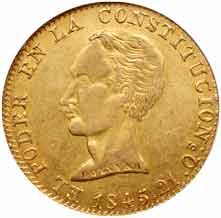
|
Sale 137
Pre-Long Beach Auction
| Lot |
Photo |
Description |
Realized |
Lot 1102 |
 |
Ecuador-Republic. 8 Escudos, 1840-MV. Fr-3; KM-23.2. Stars and zodiac over two mountains with castle and dove on peaks. Reverse; Draped female bust with LIBERTAD on head band. This piece is well struck with considerable original mint luster. This type has always been considered rare. Nice quality specimens are decidedly elusive and always attract numerous bidders. Pop 1; 1 in 62. This coin photo in the PCGS Pop Report. PCGS graded MS-60. Estimated Value $10,000 - UP
Ex Goldberg Sale 34, Feb 5, 2006, lot 2177.
View details and enlarged photos
Realized
$10,200 |
|
Lot 1103 |
 |
Ecuador-Republic. 8 Escudos, 1845-Quito MV. Fr-7; KM-31.Bare-headed portrait of Simón Bolivar facing left, his name engraved in incuse letters at the base of his neck, date 1845 below; surrounding Spanish legend translates as "The Power In [Authority Of) the Constitution" along rim, open field around the portrait. Reverse design displays the national arms on a rectangular shield, cormorant above with spread wings, two draped flags on each side with ends of cannons protruding, denomination given as "8E" split to sides of the central motif, surrounding legend along rim REPUBLICA DEL ECUADOR, and finally the mint's name, QUITO, along the bottom rim followed by the assayer's initials ("M.V."). Spanish money has a long history of including the name of the assayer of the alloy used to make coins from specific dies; it was a way of assuring quality because any deficient money could be traced back to the assayer, in this coin's case Miguel Vergara. As a consequence these coins were trusted internationally as well as in the homeland. Pop 1; 1 in 58; 1 in 61. This coin photo in the PCGS Pop Report. PCGS graded AU-53. Estimated Value $25,000 - UP
About 300 years before this coin was made, Spanish explorers seized control in Spain's name of this small coastal territory just south of present-day Colombia on the northwest corner of what is now Peru. The conquistadors founded Quito, now the capital, in 1534 on the site of the Incan city. For two centuries this land was not independent but was a portion of what was known as the Viceroyalty of New Granada. The colony consisted of large estates owned by Spaniards and worked by Indian peons. During the early 1820s, Spanish possessions in the Americas fought wars of independence from Spain, the most famous combatant being Bolivar, who has since been celebrated endlessly in South America as the liberator. His valiant lieutenant, Antonio Sucre, achieved freedom for Ecuador, in Bolivar's name, in a battle of May 1822. Under Bolivar's rule, Ecuador was united with Panama, Colombia and Venezuela in a confederation known as the Republic of Gran Colombia. In due course, each country declared itself independent. In 1830, Ecuador became a "republic" under the rule of Juan José Flores who had been one of Bolivar's prominent supporters, a military leader whom Bolivar appointed as governor of Ecuador when it was part of Gran Colombia.
Beginning in 1845, discontent with the new republic spread across the country, leading to insurrection and 15 years of turbulent in-fighting. The national mint at Quito began issuing coins that might inspire national pride and patriotism-as a way of calming the embattled citizenry. These coins presented images of the liberator, Simón Bolivar. For centuries during colonial rule, each territory in Central and South America had used Spanish coins for money. After independence, each issued new money but some shared elements of similar designs, reflecting their shared origins. Shortly after gaining its sovereignty, Ecuador minted coins that were mostly smaller silver denominations. Many of its early coins depicted images of liberty (some very similar to U.S. coins of the time). The gold 8-escudos, its largest coins, departed from this tradition from 1844 to 1856 by honoring Simón Bolivar, as seen on this 1845-Quito Mint 8-escudos. Two other versions followed-all made in small quantities. Each is very rare as few have survived. Ecuador's money changed entirely when it converted from the old denominations to a decimal coinage beginning in 1872. The gold coin seen here is a quintessential memento of Ecuador's long struggle toward self-rule under a constitutional government.
Ex Goldberg Sale 44, Feb 10, 2008, lot 3847.
View details and enlarged photos
Realized
$18,600 |
|
|
|